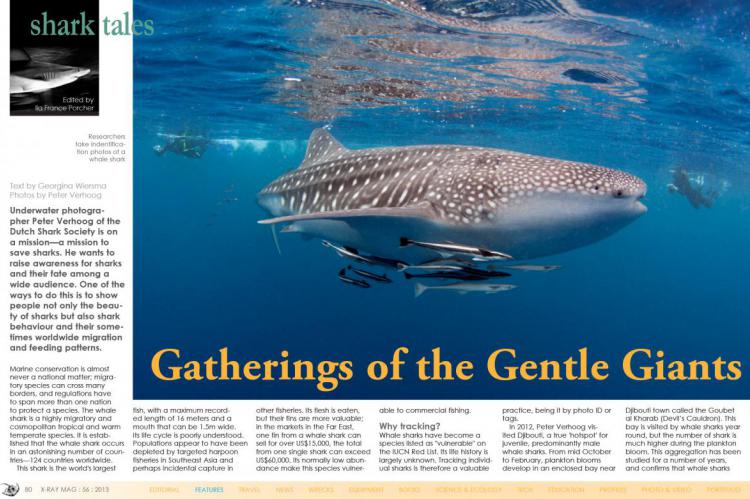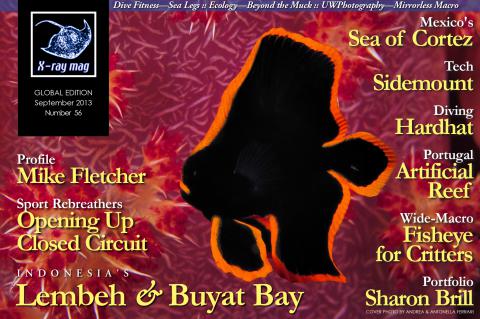Gatherings of the Gentle Giants
Underwater photographer Peter Verhoog of the Dutch Shark Society is on a mission—a mission to save sharks. He wants to raise awareness for sharks and their fate among a wide audience. One of the ways to do this is to show people not only the beauty of sharks but also shark behaviour and their sometimes worldwide migration and feeding patterns.
Tags & Taxonomy
Why tracking?
Whale sharks have become a species listed as "vulnerable" on the IUCN Red List. Its life history is largely unknown. Tracking individual sharks is therefore a valuable practice, being it by photo ID or tags. In 2012, Peter Verhoog visited Djibouti, a true 'hotspot' for juvenile, predominantly male whale sharks. From mid October to February, plankton blooms develop in an enclosed bay near Djibouti town called the Goubet al Kharab (Devil’s Cauldron). This bay is visited by whale sharks year round, but the number of shark is much higher during the plankton bloom. This aggregation has been studied for a number of years, and confirms that whale sharks aggregate in certain areas rich in nutrients to feed on seasonal aggregations of tropical krill and bait fishes. They just follow their food, and depending on the type of plankton, the numbers rise and fall. A team of volunteers snorkels with the sharks, and supports the research team of the Marine Conservation Society of the Seychelles to identify sharks by taking photos of the spots on their left and right sides. These spots are like fingerprints, and every shark has a unique pattern that can be identified with special matching software. All other markings, like scars, are documented as well. It is also noted, which fish species accompanies the whale shark, as this gives an indication about the route they have taken—close to reefs, or through the open ocean.Conservation photography is different
For a conservation photographer, it is just not ‘done’ to interfere with research. The latter is the most important part and main goal of any research expedition, and contrary to any 'tourist’ expedition, the photographer is the last in line to approach the animals. And you have to work incredibly fast, as the last person to approach an animal, you are very often confronted with just the tail. It was an exciting trip, with large numbers of whale sharks—391 in the first week, 319 in the second week and 370 in the third week. The research team also fished for plankton, took ID pictures and skin samples and tagged a number of sharks. Watch energetic and full of life teens +18 get naked on cam! Kinky young girls look to explore their sexuality with you. Everyone accessing this site must be at least 18 years of age OR the age of majority in each and live sex Join us now! Thousands of Users Online. 8000+ Girls Online. Cam-To-Cam Chat. Chat With Friendly Girls. 10000+ Live Cam Girls. Since 2010, the sharks are measured using laser photo-grammetry. Verhoog documented all procedures, and all his pictures can be used freely by researchers, students and non-profit organizations.Moving on to Australia
In April 2013, Verhoog joined doctor Mark Meekan of the Australian Institute of Marine Science on his yearly trip to Ningaloo Reef, another whale shark hot spot. Adult whale sharks turn up at Ningaloo every year from about March through to the end of July. But where do they go afterwards? Meekan is determined to find out. He has been attaching tracking devices and cameras to the whale sharks, which have revealed some startling facts. During his research, a spotter plane searches for whale sharks, and informs the team about their location. Tag data has revealed that whale sharks seem to head out in different directions. Some go to Southeast Asia, others swim up north to Indonesian waters, and some head for the open ocean. During their journeys, whale sharks can travel 30 kilometers a day and make deep dives to over 1,000 metres. And one tag, attached at Christmas Island in 2008, was even collected at the home of a fisherman, who found it collecting turtle eggs on a beach and had taken back to the village. Thanks to Google Earth, an assistant of Mark Meekan paid him a visit and collected the tag. It was probably ripped off by a predator. .... (...)Download the full article ⬇︎

Originally published
X-Ray Mag #56
Diving Indonesia's Lembeh Strait and Buyat Bay; Mexico's Sea of Cortez; Portugal's artificial reef; Sidemount diving; Hardhat diving; Opening up closed circuit; Interview with Mike Fletcher; Beyond the muck ecology; Sea legs for dive fitness; Wide-macro fisheye photography for critters; Mirrorless macro underwater photography; Sharon Brill portfolio; Plus news and discoveries, equipment and training news, books and media, underwater photo and video equipment, turtle news, shark tales, whale tales and much more...































